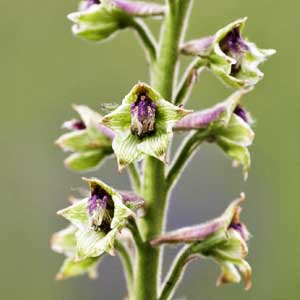Delphinium viridescens
Delphinium bicolor
Wenatchee larkspur
Basal and lower cauline leaves long-petiolate, the blades up to 10 cm. broad, divided into 3 main wedge-shaped lobes, these once or twice cleft into oblong-rounded segments; mid-cauline leaves short-petiolate and overlapping, nearly erect, divided into narrow, acute segments, abruptly transitional to the lower leaves, but gradually transitional to the linear, entire, bract-like upper leaves.
Leaves few, long-petiolate, mostly basal, the blades 2-6 cm. broad, 2-4 times parted or lobed into linear or oblong-lanceolate segments 1.5-5 mm. broad;
cauline leaves much reduced upward.
Inflorescence usually a simple, narrow raceme, the pedicels shorter than the flowers;
sepals 5, purplish, but strongly streaked with yellow or greenish-yellow, oblanceolate, glandular, 7-11 mm. long;
spur thick, straight, 7-10 mm. long;
petals 4, yellowish or purple, the lower pair densely soft-hairy, equaling the sepals;
stamens numerous;
pistils 3.
Inflorescence simple or compound, the racemes 3-15 flowered; the lower pedicels several times as long as the flowers, spreading or ascending;
sepals 5, deep purplish-blue, widely spreading, 17-25 mm. long, the lower pair the largest; the spur 13-20 mm. long, from about as long to twice as long as the top sepal;
petals 4, small, the lower pair sometimes brownish or yellow-purplish, or all deep purplish-blue, the blade 3-4 mm. long, deeply bi-lobed;
stamens numerous;
pistils 3.
Follicles 6-8 mm. long, erect, densely glandular-pubescent.
Follicles 15-22 mm. long, somewhat spreading.
Specimen records from west of the Cascade Mountains need to be re-examined.



